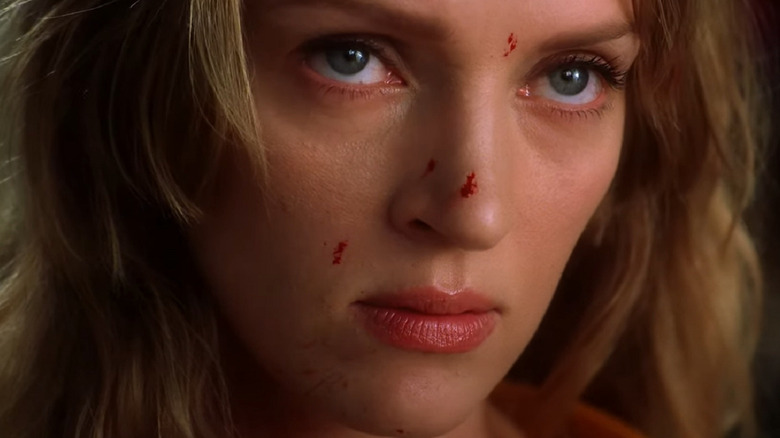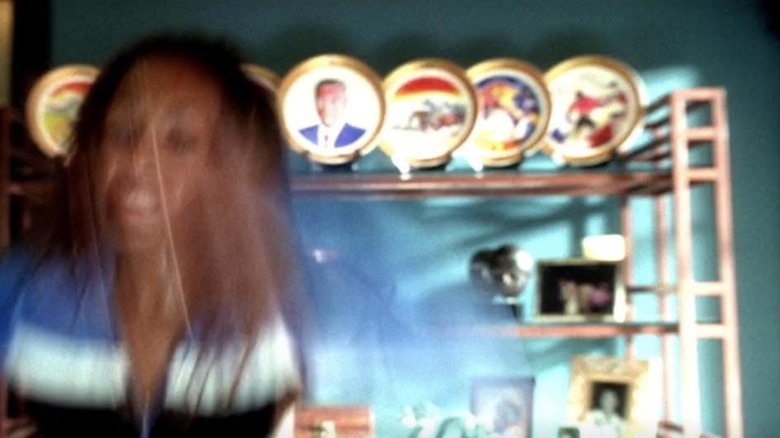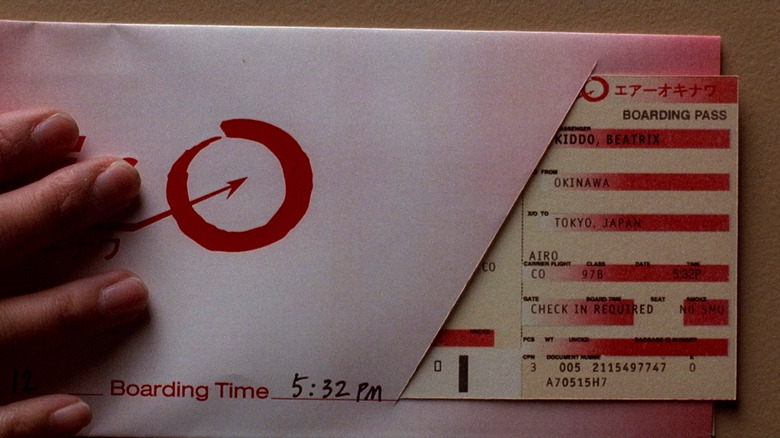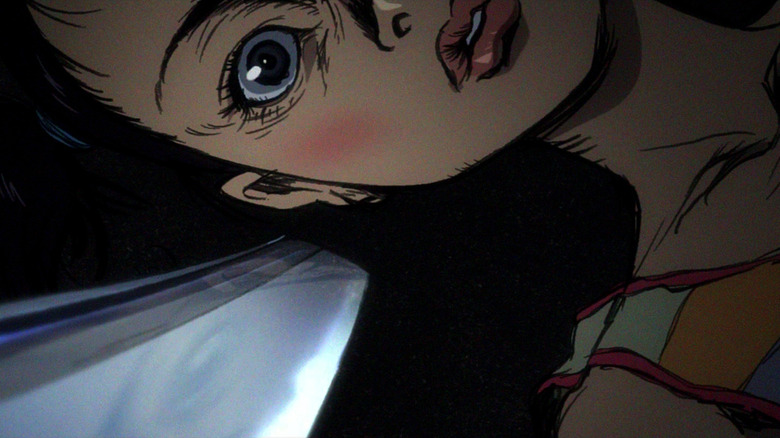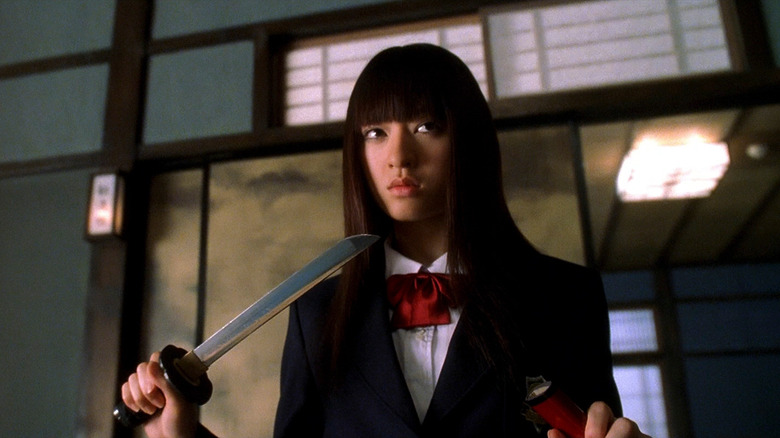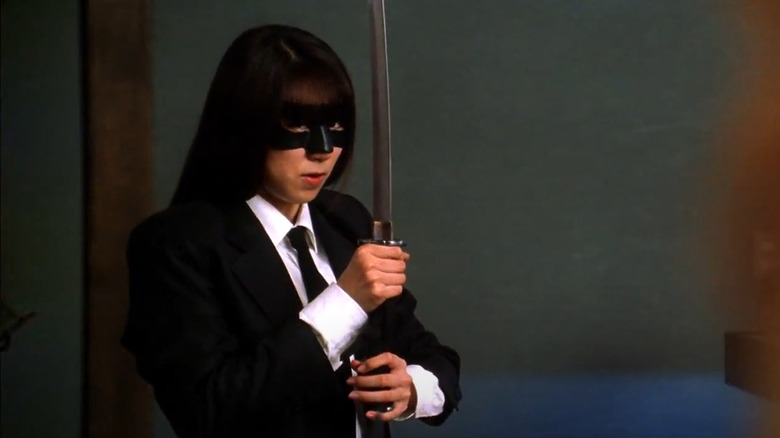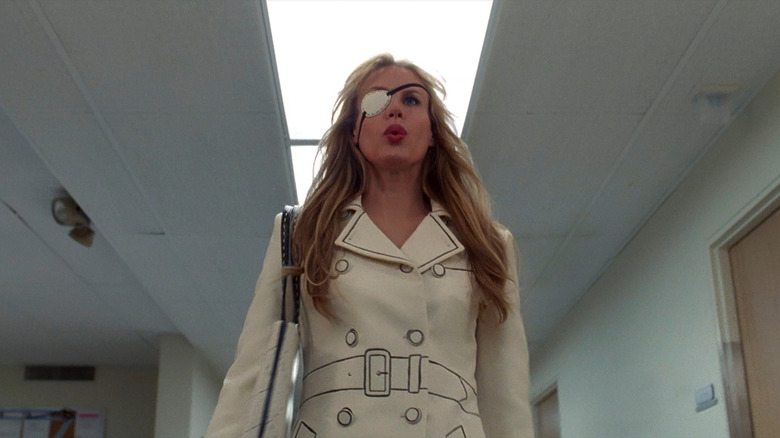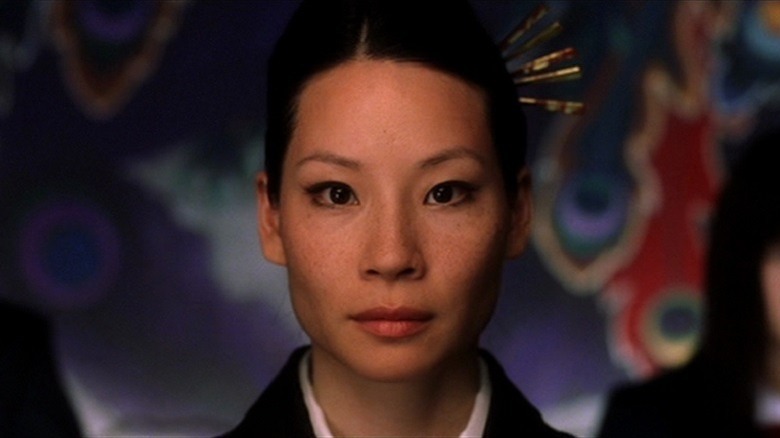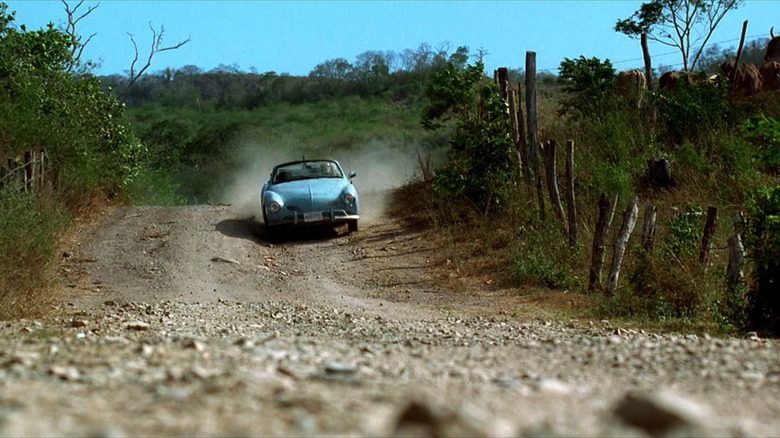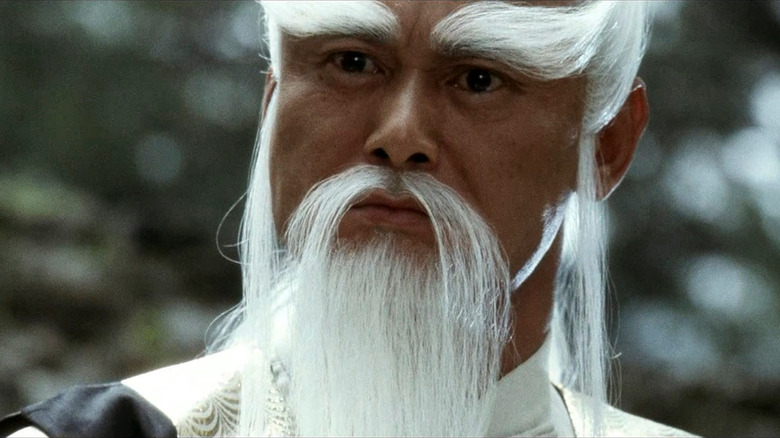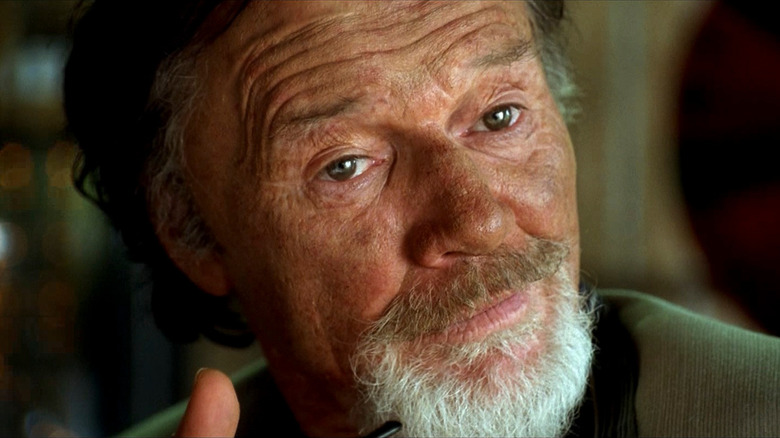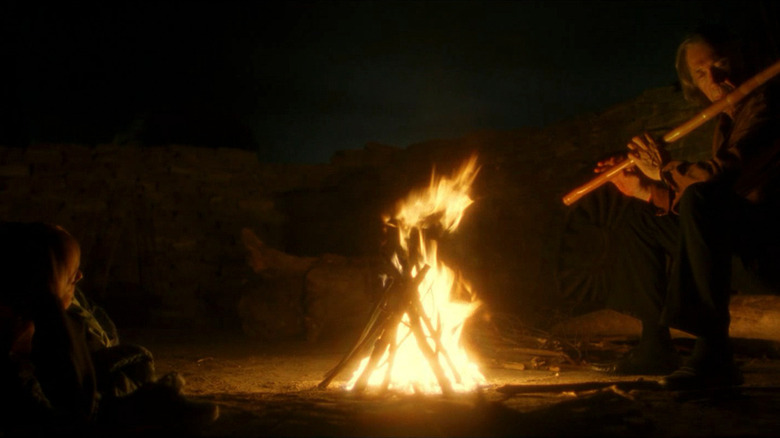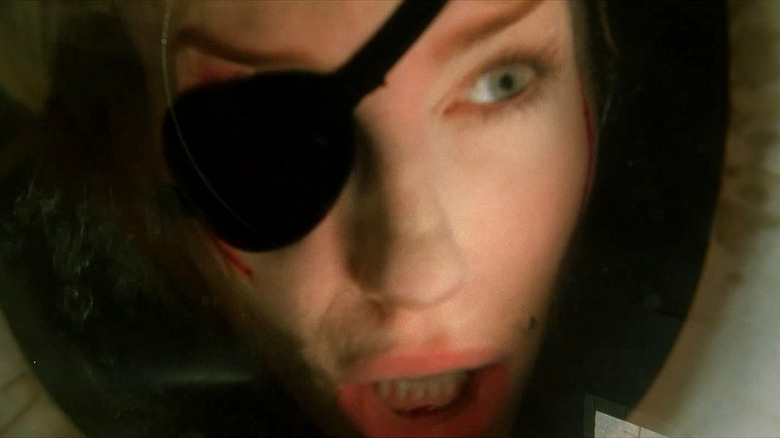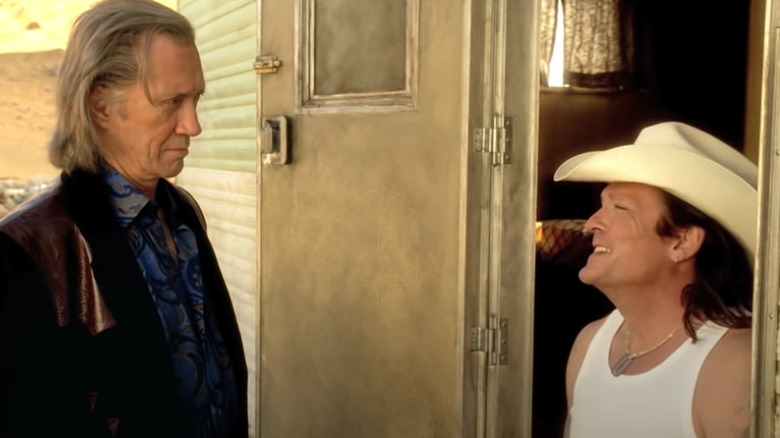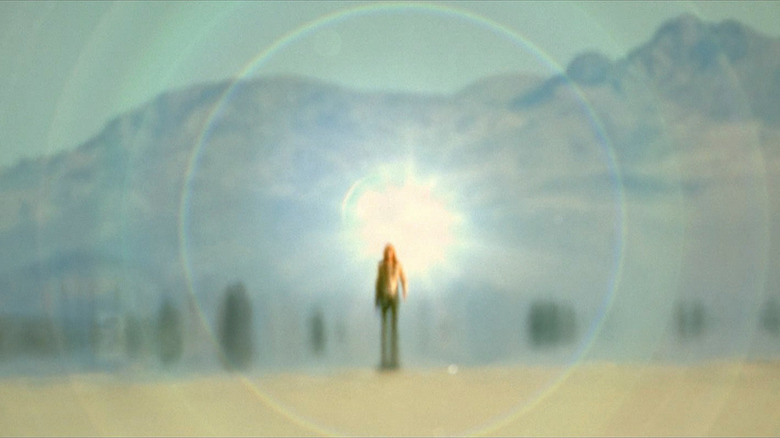Things You Might Not Know About The Kill Bill Movies
While they may tell a tale of revenge, death, and destruction, the "Kill Bill" films are ultimately a love story. Not between the fierce Beatrix Kiddo (Uma Thurman) and her titular toxic killer/lover Bill (David Carradine). And not even between our samurai sword-wielding heroine and the daughter she presumed dead. No, this two-part bloodbath is a romance between Quentin Tarantino and the films that shaped him as a director. The result is a duology rich with references, homage, and loving details. And even if you're the most fervent fan of the tale of the Bride's quest to slay her would-be-killers one by one, it's darn near impossible to catch every metatextual Easter egg.
Add to this to the usual hidden tidbits that color any cinematic venture (cameos and unfilmed sequences and juicy collaborations, oh my!), and there's always something new to learn about the "Kill Bill" films. So, if you're hankering to learn more details about Tarantino's bloody revenge tale, strap in, and beware — light spoilers ahead.
The commemorative plates in Vernita's Green's house
After the credits of "Kill Bill: Vol. 1" roll, we're dropped into the deep end, which is to say, suburbia. The Bride has zeroed in on her first target, Vernita Green, aka Copperhead (Vivica A. Fox). A member of the Deadly Viper Assassination Squad, Vernita was present at the Two Pines church where she helped beat the Bride black and blue. And now the Bride has come to return the favor, albeit with a firmer sense of finality.
As the two women exchange blows in Vernita's living room, you'd be forgiven for overlooking the minutiae of set-dressing. Flying fists are far more fascinating than throw pillows and glass-topped coffee tables, right? That said, a closer look at the scene (and the script) reveals a crunchy piece of character detail. Early into the fight, the Bride kicks Vernita into a shelf sporting a series of commemorative plates. As the script details, the plates depict various scenes of the Black experience in the American military, from the revolutionary fighter Crispus Attucks to Buffalo soldiers to World War I troops. We barely get to meet Vernita Green before the Bride takes her out, but the detail hints at who she was before retiring behind a white picket fence — a fighter from a long line of fighters.
The Bride's name is hidden in plain sight
Right from the opening shot of "Kill Bill: Vol. 1," where the Bride gasps furiously on the floor of the Two Pines church as Bill monologues over her broken body, we're led to believe that "kiddo" is only a term of endearment. Of course, Bill's pitiful tone feels less like the vehicle for a pet name and more like venom-rich condescension. It's infantilizing, surely, we think — a hint at the tension in the pair's romantic/mentor-mentee dynamic. But later, while the Bride (as we've come to know her) makes her way to Japan in search of a legendary sword master, keen-eyed viewers are let in early on the joke: Her name is Beatrix Kiddo. It's written right there, plain (or is that plane?) as a clear blue day on her boarding pass.
Then again, you can hardly forgive a first-time viewer for missing out on such a detail. However unobstructed the Bride's government name may be in hindsight, it's worth remembering the flurry of events in which it's couched. In mere seconds, the Bride has regained power over her catatonic body, hijacked her abuser's, uh, colorfully named vehicle, and declared her port of call to the cheery Air-O ticket agent: Okinawa, one-way. In the rush, it's hard to read the fine-print, however un-obscured.
A Bollywood film inspired the inspired the animated segments in Vol. 1
A striking segment in a film full of back-to-back striking segments, the tale of O-Ren Ishii (Lucy Liu) plays out in a bloody and evocative animated sequence. The hand-drawn anime tale that makes up "Chapter Three: The Origin of O-Ren" was overseen by Katsuji Morishita, an animation producer for Production I.G (the folks behind "Attack on Titan"). What fans of the "Kill Bill" films might not know, however, is that the sequence was inspired by a 2001 Hindi-Tamil psychological thriller that uses a similar stylistic flourish to depict scenes of violence. "Aalavandhan" tells of a mentally disturbed serial killer who unleashes his violent tendencies on his brother's fiancée.
As relayed by the Indian news site Mid-Day, producer Anurag Kashyap asked Quentin Tarantino about the sequence at the Venice Film Festival, to which Tarantino replied, "Yes, I saw this Indian serial-killer film which showed violence as animated." As the film's star (and co-writer) Kamal Haasan put it to Mid-Day, "When I did the animation action sequence 12 years ago, it was seen as self-indulgent and odd by a lot of people." But as Tarantino was clearly able to intuit, animation is a clever way to get away with depicting violence that otherwise wouldn't fly. And given all the messed-up stuff that takes place in O-Ren's backstory, boy, are we sure glad "Aalavandhan" gave Tarantino the idea to couch all that gore in something a little more palatable.
An unmade film was planned around Gogo's twin sister
Here's the thing, we're not sure which is a harder fact to wrap our minds around — that Gogo Yubari has a twin sister or that said twin sister is more of a nightmare than Gogo. Portrayed by Chiaki Kuriyama ("Battle Royale"), the Bride herself describes Gogo thus: "What she lacks in age, she makes up for in madness." A meteor hammer-wielding nightmare in the guise of a school girl, there's a reason Gogo acts as O-Ren's personal bodyguard. She's fierce, fearless, and fantastically good at doling out pain.
As relayed in a 2004 interview with IGN, Quentin Tarantino initially had a whole storyline developed around Gogo's sister, Yuri. "In the original script," he explained, "there was an extra chapter called 'Yuki's Revenge', and it was about Gogo's twin sister, and she chased the Bride down in Los Angeles after she's killed Vernita, and it's the only part of the movie that has a huge gunfight kind of thing ... Yuki's even crazier than Gogo." Tarantino continues, expressing his desire to film the "big ass action scene" even as an anime sequence. As he explains, there ultimately wasn't time (or money) for the shootout in a film already pushing three and a half hours. Our loss.
Sonny Chiba's daughter is in the Crazy 88
Sonny Chiba is truly a man who needs no introduction. The Japanese actor and martial artist has a list of credits longer than a CVS receipt. And his prolific career (particularly in action-filled genre films and his output for Toei Studios) no doubt put him squarely on Quentin Tarantino's radar. The way you can tell that Tarantino is a Sonny Chiba fan is that his characters are Sonny Chiba fans. In the Tarantino-penned "True Romance," Clarence (Christian Slater) absolutely loves Chiba, citing him as "the greatest actor working in martial arts movies today." If you yourself, dear reader, are a Chiba fan, you may have noticed some similarities between the iconic Ezekiel 25:17 speech in "Pulp Fiction" and the opening crawl to 1973's "Karate Kiba".
All to say, it's hardly no surprise to see Tarantino team-up with Chiba in "Kil Bill: Volume 1," casting the screen legend as the famous sword-maker Hattori Hanzō. But did you know another member of the Chiba clan makes an appearance in "Kill Bill?" Yep, Juri Manase, Chiba's daughter, numbers amongst the Crazy 88, O-Ren Ishii's personal army. If you want to spot Manase, she's one of the first of the 88 to cheese it, credited as "Crazy 88 #6 (Girl)".
There's a reason so much of the music in Vol. 1 sounds familiar
You can't throw a stone at the "Kill Bill" films without hitting a cinematic reference. For example, there's the Bride's iconic black and yellow tracksuit, a clear nod to Bruce Lee's final film, 1978's "Game of Death," and the Bride's snowy brawl with O-Ren Ishii pays homage to the 1973 Japanese revenge film "Lady Snowblood." The films are an unapologetic love letter to the genre films director Quentin Tarantino adores. And, if you listen carefully, the film's score reflects that.
Almost all of the needle drops and songs you hear (especially in "Kill Bill: Volume 1") are swiped from other films. The tune Elle Driver whistles as she infiltrates the hospital is "Twisted Nerve," the main theme from the 1968 psychological thriller of the same name, composed by Bernard Herrmann of "Psycho" fame. During the House of Blue Leaves throwdown, Ennio Morricone's "From Man to Man" from "Death Rides a Horse" can be heard, as can Shunsuke Kikuchi's "Champions of Death" from the Sonny Chiba-starring film of the same name and "Police Check Point" from the film "Black Mama White Mama." The (track) list goes on and on!
Tarantino wanted to replicate the look of 'samurai movie blood'
Okay, look, we know that this is going to sound weird, but attention to detail is important when it comes to blood. If you're a fan of Italian giallo films, you'll know the importance of that impossible, candy-apple red — too bright and vivid, it looks more out of a dream than a human body. If you're more of a fan of French Extremity, the genre defined by its wanton disregard for the sanctity of flesh and form, you're doubtlessly aware of the brown, rust-colored hues that give that blood a stomach-churning realistic punch.
As this TIME article estimates, around 450 gallons of fake blood were employed across both "Kill Bill" films. (For those having difficulty visualizing that, 450 gallons is just over 100 standard bathtubs). And for Quentin Tarantino, the look of that blood was very particular — yet another knowing nod to his beloved samurai films. Again, per TIME, Tarantino explains, "I'm really particular about the blood, so we're using a mixture depending on the scenes. I say, 'I don't want horror movie blood, all right? I want samurai blood.' You can't pour this raspberry pancake syrup on a sword and have it look good. You have to have this special kind of blood that you only see in samurai movies." We won't pretend to know what that means (and we'll try not to take that as a dig at giallo blood), but if there's one man liable to obsess over cinematic blood aesthetics, it's Tarantino.
Uma Thurman got seriously injured during a stunt
Most of the entries on this list are relatively light-hearted tidbits. They're the kind of fun facts that will compel you to become that friend who leans over mid-screening to enlighten your fellow watchers with your newfound knowledge. Unfortunately, the following is deadly serious.
In a profile by The New York Times published in February 2018, Uma Thurman shattered the illusion that her creative partnership with Quentin Tarantino was all sunshine and rainbows. In the interview, she recalled an incident that took place on-location in Mexico during the end of the "Kill Bill" shoot. Thurman describes being caught off guard when she was asked to drive a blue convertible herself. Thurman was suspicious of the car, which had undergone major work to refit an automatic transmission, but as she tells it, Tarantino brushed away her objections.
"That was a deathbox that I was in," she told The New York Times. "The seat wasn't screwed down properly. It was a sand road, and it was not a straight road." Sure enough, as footage obtained by Thurman (15 years later) shows, the car was not drivable, careening off the road and crashing into a palm tree. As Thurman tells it, she feared that she would never walk again. "Quentin and I had an enormous fight, and I accused him of trying to kill me." Thurman underlines that the crash has permanently affected both her neck and knees.
Tarantino was going to play Pai Mei
There is a long, and generally amusing, history of directors sneaking cameo appearances into their filmography. The work of Alfred Hitchcock is a veritable "Where's Waldo?" with the infamous thriller director pulling sneaky, almost out-of-frame walk-ons in much of his feature films. But while some directors find titillation in insignificant off-screen roles or blink-and-you'll-miss-it drive-by appearances, others operate with a little less, uh, subtlety.
Quentin Tarantino is no stranger to the director cameo rodeo, appearing both on and off-screen (and sometimes both) in almost all of his feature films. For "Kill Bill," the original plan was for the director to play Pai Mei, the legendary kung fu master the Bride seeks out in "Kill Bill: Volume 2." According to a 2004 IGN interview, Tarantino event went so far as to join the core cast during training sessions. Wanting to focus on directing and recognizing that he had the incredible Gordon Liu at his disposal, Tarantino ultimately resolved that "it was almost criminal not to cast him, so it became a very easy decision."
While it's unclear if Tarantino intended to play Pai Mei in yellowface, suffice to say, we have to agree with the man himself — casting Liu was a very good decision. And, in the end, Tarantino would voice a parody of Pai Mei in a cameo appearance in a 2005 "Duck Dodgers" episode, so he got to scratch that itch.
There are two double-duty actors in the Kill Bill films
There are not one but two supporting actors who pull double duty across the "Kill Bill" films. The first, and perhaps the most obvious, is Gordon Liu. In "Kill Bill: Volume 1," Liu appears as Johnny Mo, the Kato mask-wearing ringleader of the Crazy 88. Mo is one of the only members of O-Ren's personal army to truly pose a threat to the Bride, giving Liu ample opportunity to flex his muscles as a skilled martial artist. In "Kill Bill: Volume 2," Liu reappears as the beard-flipping, tough-love dispensing kung fu trainer Pai Mei, the grandmaster who teaches both the Bride and Elle Driver how to fight.
The other actor who puts in overtime across the "Kill Bill" films is Michael Parks. In "Vol. 1" and "Vol. 2," Parks makes a brief appearance as Earl McGraw, the Texas ranger who investigates the massacre at the Two Pines chapel and discovers that the Bride is very much alive. Unless you're familiar with Parks' work, his second appearance may be difficult to spot. That's him under all that self-tanner and sweat as Esteban Vihaio, the Mexican pimp. Fun fact: "Kill Bill" wasn't the first or last time audiences were treated to the southern charm of Earl McGraw. The fictional cop originated in the Tarantino-penned vampire Western "From Dusk Till Dawn" and returned in both "Death Proof" and "Planet Terror" segments of 2007's "Grindhouse".
Robert Rodriguez wrote the score for Kill Bill: Vol. 2
United by a shared love of the ickier corners of genre cinema, Robert Rodriguez and Quentin Tarantino aren't just giants of independent film, they're close pals! The pair reportedly met at the Toronto International Film Festival in 1992 and a fruitful creative partnership was born. The pair have collaborated numerous times, from co-directing ("Grindhouse", "Sin City") to acting in each other's projects ("From Dusk Till Dawn," "Desperado"). Heck, Tarantino even suggested that Rodriguez should take the reins on a "Once Upon a Time in Hollywood" spinoff during an interview on Jeff Goldsmith's podcast.
However, not all of the pair's team ups are so easy to spot. As quoted in this IGN interview with Wu-Tang Clan leader RZA (who composed for and consulted on "Kill Bill"), "When we did ["Kill Bill: Volume 2"], you know, we brought Robert Rodriguez in." RZA continues, "Check this out, he took my music and kept the foundation there, though. With Robert, he didn't want to remove any of the electronic [sounds] ... so he took the electronic stuff and kept it there, then built the orchestrations on top of it." Per the same article, Rodriguez was drawn to the project specifically to collaborate with RZA. As the legend goes, Rodriguez performed his musical duties for a discount price of $1.
The brawl between the Bride and Elle Driver was inspired by Jackass
What's the first thing you think about when you think about the fight scenes in the "Kill Bill" films? Is it elegant samurai swords and wire work? Gravity-defying flips and well-placed heart-exploding finger tips? Well, it turns out you should also be thinking about a gaggle of guys getting smacked in their sensitive bits because in addition to a respectable host of kung fu influences, one of the fights in "Kill Bill" was inspired by "Jackass," more specifically 2002's "Jackass: The Movie." If somehow the cultural phenomena of "Jackass" sailed over your head like a skybound porta potty, fear not, for the premise is simple: A bunch of fearless thrill-seekers put their minds and bodies (but mostly their bodies) at risk for our entertainment.
As Daryl Hannah tells it in this 2004 article from Entertainment Weekly, "Quentin [Tarantino] had become obsessed with the movie 'Jackass.'" So when it came time to stage the brawl between the Bride and Elle Driver (Hannah), Tarantino looked to the fearless lads for inspiration. "This is just a barroom brawl gone wrong," Hannah continued. "So even though this was written as a standoff ... it turned into just a gross and nasty 'Jackass' fight," replete with normal household items (yes, including a toilet) re-imagined as deadly weapons. Rubbing shoulders with other cinematic influences like the "Dollars" trilogy and ""The Bride Wore Black," we'd like to think the "Jackass" boys would be proud.
The feud between Bill and Budd had to do with a woman
Bill (David Carradine) and his younger brother Budd (Michael Madsen) are one heck of a pair. The latter works for the former as a member of the Deadly Viper Assassination Squad and played a direct part in the brutalization of the Bride. So you'd think the two would be thick as thieves, or, uh, violent, smooth-talking assassins, right? Wrong. As depicted in "Kill Bill: Volume 2," a tension exists between the duo, with Budd refusing assistance from his older brother and exhibiting more saltiness than the rock salt he later shotguns into the Bride's chest.
So, what gives? Well, if we take David Carradine at his word per this interview with Coming Soon from 2004, the bad blood between Budd and Bill had to do with their shared love of none other than Elle Driver. As Carradine tells it, one of the narrative wrinkles that got left on the cutting room floor was a deeper explanation of the relationship between Driver and Bill, and "it would also explain what's the matter between me and my brother because he won't talk to me and that can only be a women, and it can only be Daryl [Hannah], and you know that they hate each other." Sounds messy!
Vol. 1 and Vol. 2 were inspired by different genres
Even if you haven't seen every kung fu and revenge film in Quentin Tarantino's film library, you're doubtlessly aware that the "Kill Bill" films are riddled with homage. What's fascinating, however, is the way both films lean in different directions as far as their inspirations are concerned. Where "Vol. 1" is more indebted to Eastern cinema, "Vol. 2" is much more tied to Westerns. "Vol. 1" is much more focused on highlighting kung fu flicks (which it has ample opportunity to do in its final brawl sequence) and samurai classics (with the Bride seeking out a sword worthy of exacting her vengeance). Meanwhile, "Vol. 2" is pulling musical stings from "Navajo Joe" and using the Texas landscape to evoke similarities to the sweat-flecked, hazy images of spaghetti Western icons like Sergio Leone.
Indeed, while both films lean a little harder in one direction, both invoke elements from both genre film traditions. Which, in truth, makes a lot of sense given that the relationship between Westerns (especially the Italian-made output of the 1960s and 1970s) and Eastern genre films is deeply reciprocal. Movies like "Seven Samurai" and "Yojimbo" directly influenced iconic Westerns "The Magnificent Seven" and "A Fistful of Dollars," respectively. It's a revenge-filled match made in genre heaven, and it makes a ton of sense that Tarantino would bring the two cinematic traditions together under his two-part roof.
